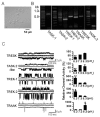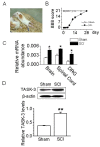Single-Channel Recording of TASK-3-like K Channel and Up-Regulation of TASK-3 mRNA Expression after Spinal Cord Injury in Rat Dorsal Root Ganglion Neurons
- PMID: 19967063
- PMCID: PMC2788643
- DOI: 10.4196/kjpp.2008.12.5.245
Single-Channel Recording of TASK-3-like K Channel and Up-Regulation of TASK-3 mRNA Expression after Spinal Cord Injury in Rat Dorsal Root Ganglion Neurons
Abstract
Single-channel recordings of TASK-1 and TASK-3, members of two-pore domain K(+) channel family, have not yet been reported in dorsal root ganglion (DRG) neurons, even though their mRNA and activity in whole-cell currents have been detected in these neurons. Here, we report single-channel kinetics of the TASK-3-like K(+) channel in DRG neurons and up-regulation of TASK-3 mRNA expression in tissues isolated from animals with spinal cord injury (SCI). In DRG neurons, the single-channel conductance of TASK-3-like K(+) channel was 33.0+/-0.1 pS at -60 mV, and TASK-3 activity fell by 65+/-5% when the extracellular pH was changed from 7.3 to 6.3, indicating that the DRG K(+) channel is similar to cloned TASK-3 channel. TASK-3 mRNA and protein levels in brain, spinal cord, and DRG were significantly higher in injured animals than in sham-operated ones. These results indicate that TASK-3 channels are expressed and functional in DRG neurons and the expression level is up-regulated following SCI, and suggest that TASK-3 channel could act as a potential background K(+) channel under SCI-induced acidic condition.
Keywords: Acidosis; Dorsal root ganglion; Spinal cord injuries; Two-pore domain K+ channel.
Figures



References
-
- Basso DM, Beattie MS, Bresnahan JC. A sensitive and reliable locomotor rating scale for open field testing in rats. J Neurotrauma. 1995;12:1–21. - PubMed
-
- Braughler JM, Hall ED. Effects of multi-dose methylprednisolone sodium succinate administration on injured cat spinal cord neurofilament degradation and energy metabolism. J Neurosurg. 1984;61:290–295. - PubMed
-
- Cooper BY, Johnson RD, Rau KK. Characterization and function of TWIK-related acid sensing K+ channels in a rat nociceptive cell. Neuroscience. 2004;129:209–224. - PubMed
-
- Farooque M, Hillered L, Holtz A, Olsson Y. Effects of methylprednisolone on extracellular lactic acidosis and amino acids after severe compression injury of rat spinal cord. J Neurochem. 1996;66:1125–1130. - PubMed
-
- Holzer P. Acid-sensitive ion channels in gastrointestinal function. Curr Opin Pharmacol. 2003;3:618–625. - PubMed

